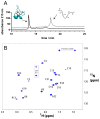NMR Structure of μ-Conotoxin GIIIC: Leucine 18 Induces Local Repacking of the N-Terminus Resulting in Reduced NaV Channel Potency
- PMID: 30360356
- PMCID: PMC6222493
- DOI: 10.3390/molecules23102715
NMR Structure of μ-Conotoxin GIIIC: Leucine 18 Induces Local Repacking of the N-Terminus Resulting in Reduced NaV Channel Potency
Abstract
μ-Conotoxins are potent and highly specific peptide blockers of voltage-gated sodium channels. In this study, the solution structure of μ-conotoxin GIIIC was determined using 2D NMR spectroscopy and simulated annealing calculations. Despite high sequence similarity, GIIIC adopts a three-dimensional structure that differs from the previously observed conformation of μ-conotoxins GIIIA and GIIIB due to the presence of a bulky, non-polar leucine residue at position 18. The side chain of L18 is oriented towards the core of the molecule and consequently the N-terminus is re-modeled and located closer to L18. The functional characterization of GIIIC defines it as a canonical μ-conotoxin that displays substantial selectivity towards skeletal muscle sodium channels (NaV), albeit with ~2.5-fold lower potency than GIIIA. GIIIC exhibited a lower potency of inhibition of NaV1.4 channels, but the same NaV selectivity profile when compared to GIIIA. These observations suggest that single amino acid differences that significantly affect the structure of the peptide do in fact alter its functional properties. Our work highlights the importance of structural factors, beyond the disulfide pattern and electrostatic interactions, in the understanding of the functional properties of bioactive peptides. The latter thus needs to be considered when designing analogues for further applications.
Keywords: NMR; protein structure; voltage-gated sodium channel blocker; μ-conotoxins.
Conflict of interest statement
The authors declare no conflict of interest.
Figures





Similar articles
-
Voltage-Gated Sodium Channel Inhibition by µ-Conotoxins.Toxins (Basel). 2024 Jan 18;16(1):55. doi: 10.3390/toxins16010055. Toxins (Basel). 2024. PMID: 38251271 Free PMC article. Review.
-
Three-dimensional solution structure of mu-conotoxin GIIIB, a specific blocker of skeletal muscle sodium channels.Biochemistry. 1996 Jul 9;35(27):8824-35. doi: 10.1021/bi960073o. Biochemistry. 1996. PMID: 8688418
-
Roles of basic amino acid residues in the activity of μ-conotoxin GIIIA and GIIIB, peptide blockers of muscle sodium channels.Chem Biol Drug Des. 2015 Apr;85(4):488-93. doi: 10.1111/cbdd.12433. Epub 2014 Sep 30. Chem Biol Drug Des. 2015. PMID: 25228447
-
Structural Basis for the Inhibition of Voltage-gated Sodium Channels by Conotoxin μO§-GVIIJ.J Biol Chem. 2016 Mar 25;291(13):7205-20. doi: 10.1074/jbc.M115.697672. Epub 2016 Jan 27. J Biol Chem. 2016. PMID: 26817840 Free PMC article.
-
Structure and function of μ-conotoxins, peptide-based sodium channel blockers with analgesic activity.Future Med Chem. 2014 Oct;6(15):1677-98. doi: 10.4155/fmc.14.107. Future Med Chem. 2014. PMID: 25406007 Free PMC article. Review.
Cited by
-
Voltage-Gated Sodium Channel Inhibition by µ-Conotoxins.Toxins (Basel). 2024 Jan 18;16(1):55. doi: 10.3390/toxins16010055. Toxins (Basel). 2024. PMID: 38251271 Free PMC article. Review.
-
Inferring Pathways of Oxidative Folding from Prefolding Free Energy Landscapes of Disulfide-Rich Toxins.J Phys Chem B. 2023 Mar 2;127(8):1689-1703. doi: 10.1021/acs.jpcb.2c07124. Epub 2023 Feb 15. J Phys Chem B. 2023. PMID: 36791259 Free PMC article.
-
Historical Perspective of the Characterization of Conotoxins Targeting Voltage-Gated Sodium Channels.Mar Drugs. 2023 Mar 27;21(4):209. doi: 10.3390/md21040209. Mar Drugs. 2023. PMID: 37103349 Free PMC article. Review.
-
µ-Conotoxins Targeting the Human Voltage-Gated Sodium Channel Subtype NaV1.7.Toxins (Basel). 2022 Aug 30;14(9):600. doi: 10.3390/toxins14090600. Toxins (Basel). 2022. PMID: 36136538 Free PMC article.
References
-
- Wilson M.J., Yoshikami D., Azam L., Gajewiak J., Olivera B.M., Bulaj G., Zhang M.M. μ-conotoxins that differentially block sodium channels NaV1.1 through 1.8 identify those responsible for action potentials in sciatic nerve. Proc. Natl. Acad. Sci. USA. 2011;108:10302–10307. doi: 10.1073/pnas.1107027108. - DOI - PMC - PubMed
MeSH terms
Substances
Grants and funding
LinkOut - more resources
Full Text Sources
Research Materials

